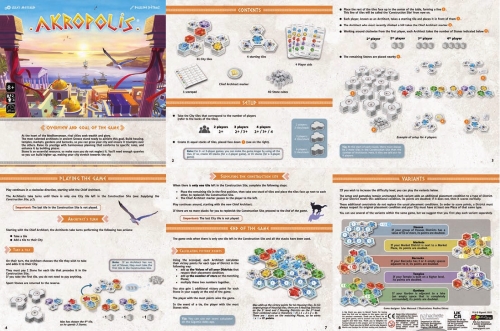Translating fun
Harriet Cooper explores the world of board game translation
Industry turnover for the worldwide board game market runs into the billions, and with around 3,000 new games released into this international market each year, the competition for sales is friendly but fierce. Are you ready to play?
Deep in the mists of time, in a land full of mystical heroes and fearsome beasts, resides the board game translator. Our intrepid hero will need to use all their skill to produce a document worthy of their exacting client. Will your game translation be a worthy competitor against the industry giants?
COMPONENTS
1 Translator
1 Proofreader
1 Project manager
Source/foreign language pdfs (including images of the game artwork and other components)
IMPORTANT: Game translation encompasses two distinct styles. First, use a clear, direct, precise and fairly concise style for the rules text. Second, use an engaging, somewhat literary style for the box blurb, narrative sections and ‘flavour text’ (a phrase or two that appears on cards to engage the player in the setting of the game).
SET-UP
TIP: Pay particular attention to numbers and symbols, because errors can easily sneak in there, especially in game examples.
- Before you start translating, make sure you thoroughly internalise the rules of the game. Read through the rules as if you are learning to play the game yourself, work out how the mechanics (the internal game structure that the rules create) function, and anticipate any questions players might have about exactly how or when things happen. Notice any questions that arise when you run through the game in your head, and request clarification from the client if necessary. This is very important, because if you don’t understand the rules properly, the players won’t either (and will be arguing about this in perpetuity in online forums).
- Pay attention to the logical flow of the game rules. For example, a particular rule might work better in another section of the rulebook, or inserting a reminder somewhere could clarify a rule.
IMPORTANT: You’ll need a good working knowledge of a wide range of games. ‘Expert’ games in particular can include a lot of jargon and assume knowledge of the mechanics of similar games.
- Extract the text from the pdf and create a bilingual table so you can easily compare the two languages once you’ve completed your translation.
- Identify the key terms in the game and come up with translations for those terms that evoke the game atmosphere (dystopia? outerspace? woodland creatures?) and will work across it.
- Often, you will come across names for imaginary characters, settings or concepts. If these need localising, think up some options that will fit the style of the game and the client’s intention for that name, which may include wordplay.
- If the game has a near-reality setting, you may need to research the specific names of some items, such as medieval weaponry or explosive devices. (Make sure you use sensible search terms to avoid attracting the attention of the local bomb squad!)
- Note the meaning of any in-text symbols. If a sentence includes a game symbol, show clearly where the symbols go in the text, as it will not necessarily be obvious to the graphic designer, especially if they do not have a strong understanding of English.
HOW TO PLAY

If you want to get involved in this field, you’ll need to have a working knowledge of a wide variety of similar games
- First think about the register required for the rules for this genre of game. A seasoned gamer will readily understand what a D12 is, but beginners will appreciate it being described as ‘a 12-sided die’. Knowing your target consumer ensures that beginners can follow the rules, and ‘expert’ gamers aren’t patronised.
- Use a simple, direct style. For many of the players, English will not be their first language, so ensure the concepts are clearly expressed. Clarity and precision are key.
- There are differences between French game style, for instance, and English game style. French often addresses the rules tole joueur (‘the player’), whereas English prefers direct imperatives, such as ‘Draw a card’. Consider how you would expect it to be expressed in an English rulebook.
- Respect the paragraphing and structure of the source language text where possible, as the English will need to fit into the same spaces in the pdfs as the source text did.
Example:
(French) Le joueur lance un D8. S’il gagne 2 réussites, il prend un jeton Jeux.
(English) Roll a D8. If you get 2 successes, gain a Games token.
- Avoid ambiguity, and check your explanation cannot be misconstrued. For example, ‘as’ can mean ‘because’ or ‘while’. This can make a big difference in game rules. Sometimes, you may need to insert a modal verb to reduce ambiguity in English. For instance, when they’re reading ‘draw a card’, the players might question whether they ‘may draw a card’ (optional) or ‘must draw a card’. These differences may seem small but they can have a significant effect on how the game plays out.
- Use gender-neutral language where possible, and note the player names in the examples. Generally, you’re aiming for a mixture of male and female names, so player names in the examples can reflect the diversity of tabletop gaming. Additionally, they may need localising, especially if they are hard to pronounce for English speakers. Be aware that player names are sometimes a nod by the designer to living persons.
- The game images can be very useful when you’re translating descriptions of creatures that don’t exist. Snatches of narrative and flavour text can often have minimal context, so if you need to know whether that fantastical, winged creature growls or screeches, you’re going to have to ask.
TIP: Spend some time making your flavour text engaging. Sometimes, the flavour text can be only a few words, but it is key for drawing the players’ attention into the game and immersing them in the narrative. It is also often used in marketing the game, so it needs to stand out.
In the recesses of your mind, you can hear a word calling for you. Grabbing hold of it, you use your last ounce of strength to extract it from its hiding place. Suddenly, the rock around it gives way and you pull it through the cobwebs. Holding it aloft, triumphantly, you recognise it to be the holy grail of your quest: the Word of Perfection!
- Be consistent with your concepts. Synonyms are unhelpful in game rules and can confuse the player. Your aim is to make the rules crystal clear, so you can sometimes end up bending the rules of grammar to reflect the game mechanics, especially in complex games. For example, if the game concept ‘suffer’ means ‘apply a certain rule’, a character could ‘suffer Angry Outburst’.
- Use capital letters to highlight Game Concepts, so they are easy to find when players are referring back to the rules. Use numerals rather than number words for the same reason. Often, a client will use bold formatting to make a crucial rule stand out, so make sure you respect those formatting decisions.
TIP: Keep an eye out for any inconsistencies across the game – spotting where errors have crept in or where a rule could be expressed more clearly are good ways to add value for your client.
GAME END
Before you hand your translation to the client, you’ll need to check it against the original source language pdfs to make sure the wording will work with any symbols; your sentences and paragraphs are a suitable length; and you haven’t overlooked anything in your translation. Your proofreader will help you spot any ambiguous wording, missing elements or other nonsense.
If you have reduced the translation’s errors to 0, proceed to the scoring phase.
SCORING
Once your English translation has been transferred into the pdf rules documents, review the English pdfs. You’ll need to check for the following:
- Errors: check for any spelling or grammatical issues, extra spaces, or incorrect placing of symbols.
- Textual layout: check that the English text fits around the images, as the length may differ from the original.
- Other aesthetic considerations: check, for example, that paragraphs are split sensibly and bullet points are lined up.
Next, you’ll need to stay really quiet about the game you’ve just translated, but keep an eye on social media for its release.
Count up your points to see whether you’ve made the grade as a board game translator. Then check your result in the table below.
| Victory points | Level | Verdict |
|---|---|---|
| 1-3 | NEEDS WORK | Oh dear – the client has picked up some inconsistencies in your translation. You’d better keep your eyes peeled when you check the English pdfs! |
| 4-7 | DECENT JOB | A solid translation. The players won’t have any trouble understanding how the game works. |
| 8-10 | OUTSTANDING | Amazing! Your translated game has won awards around the globe. Well done! |
Never miss another Bulletin article

If you would like to read more features and articles on a wide variety of subjects relating to all aspects of the translation and interpreting industry, subscribe to ITI Bulletin. Alternatively, join ITI and get a free subscription included in your membership.






